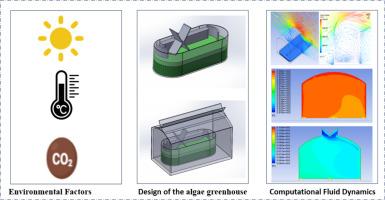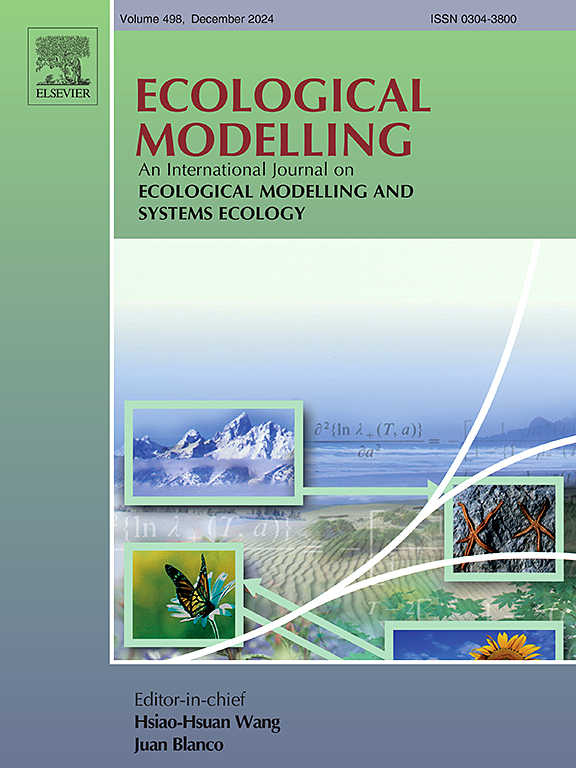优化温室设计,提高微藻产量:赛道池塘小气候和水热动力学的 CFD 分析
IF 2.6
3区 环境科学与生态学
Q2 ECOLOGY
引用次数: 0
摘要
对可持续生物质日益增长的需求使微藻类养殖成为生物燃料、营养保健品和其他有价值产品的可行来源。赛道池塘因其简单和成本效益高而成为最常见的藻类养殖系统之一。然而,其效率受周围小气候条件的影响很大。在本研究中,我们介绍了一项计算流体动力学(CFD)分析,旨在优化温室设计,以提高置于受控温室环境中的赛道池塘的微藻产量。研究重点是评估温室小气候参数对池塘水热动力学的影响。模拟评估了不同的温室几何形状和通风配置如何影响温室内水面和空气之间的热交换以及内部流动动力学,这两者对于水藻的最佳生长至关重要。具体而言,观察到池塘表面和底部之间存在 5 °C 的明显温差,这主要是由于对流传热造成的。研究表明,温室高度和通风率等关键设计因素会对水温产生重大影响。研究结果对于优化温室设计和通风策略,最大限度地提高藻类生长和生产效率至关重要。这一初步建模为未来的敏感性分析奠定了基础,旨在完善系统,最终改善受控环境农业系统中的水藻培养。本文章由计算机程序翻译,如有差异,请以英文原文为准。

Optimizing greenhouse design for enhanced microalgae production: A CFD Analysis of microclimate and water thermal dynamics in raceway ponds
The increasing demand for sustainable biomass has made microalgae farming into the spotlight as a viable source of biofuels, nutraceuticals, and other valuable products. Raceway ponds are one of the most common systems in algaculture due to their simplicity and cost-effectiveness. However, their efficiency is significantly influenced by surrounding microclimate conditions. In this study, we present a Computational Fluid Dynamics (CFD) analysis aimed at optimizing greenhouse design to enhance microalgae production in a raceway pond housed within a controlled greenhouse environment. The research focuses on evaluating the influence of greenhouse microclimate parameters on water's thermal dynamics in the pond. Simulations were conducted to assess how different greenhouse geometries and ventilation configurations affect the heat exchange between the water surface and air within the greenhouse, as well as the internal flow dynamics, both of which are critical for optimal algae growth.
The results provide insights into the optimal greenhouse design parameters that maintain the optimal water temperatures in the pond while minimizing thermal fluctuations to enhance microalgae productivity. Specifically, a significant 5 °C temperature difference was observed between the pond's surface and bottom, mainly due to convective heat transfer. Key design factors, such as greenhouse height and ventilation rates, were shown to have a substantial impact on water temperature.
The insights gained are essential for optimizing greenhouse design and ventilation strategies to maximize algae growth and production efficiency. This preliminary modeling lays the foundation for future sensitivity analyses aimed at refining the system, ultimately improving algae cultivation in controlled environment agricultural systems.
求助全文
通过发布文献求助,成功后即可免费获取论文全文。
去求助
来源期刊

Ecological Modelling
环境科学-生态学
CiteScore
5.60
自引率
6.50%
发文量
259
审稿时长
69 days
期刊介绍:
The journal is concerned with the use of mathematical models and systems analysis for the description of ecological processes and for the sustainable management of resources. Human activity and well-being are dependent on and integrated with the functioning of ecosystems and the services they provide. We aim to understand these basic ecosystem functions using mathematical and conceptual modelling, systems analysis, thermodynamics, computer simulations, and ecological theory. This leads to a preference for process-based models embedded in theory with explicit causative agents as opposed to strictly statistical or correlative descriptions. These modelling methods can be applied to a wide spectrum of issues ranging from basic ecology to human ecology to socio-ecological systems. The journal welcomes research articles, short communications, review articles, letters to the editor, book reviews, and other communications. The journal also supports the activities of the [International Society of Ecological Modelling (ISEM)](http://www.isemna.org/).
 求助内容:
求助内容: 应助结果提醒方式:
应助结果提醒方式:


